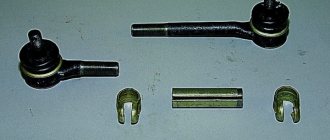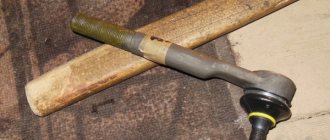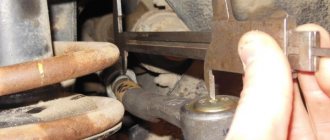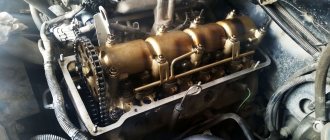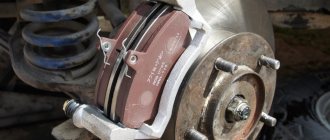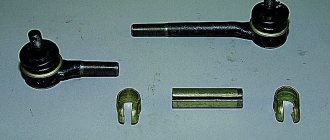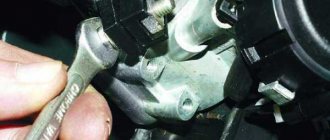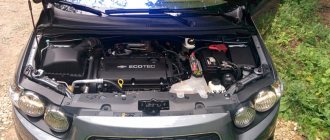One of the important elements in a car is the steering, thanks to which the vehicle turns. Failure of any part included in this mechanism can lead to unpredictable consequences. Therefore, it is very important to monitor the condition of all parts. Particular attention should be paid to the steering rods, which connect the steering knuckle and the steering wheel; thanks to this design, the wheels turn.
Diagram and description of the design
In the steering design, the tie rod ensures the transmission of force from turning the steering wheel to the steering knuckles of the wheels. This part is made in the form of a steel rod; movable ball pins with threads are installed at the ends.
The kit includes left, right and middle adjustable rods and tie rod ends of various lengths. Steering rods provide control of the car on the road and the ability to turn the wheels in the desired direction.
But as you know, the more moving parts there are in a mechanism, the greater the likelihood of wear and failure of one or more parts.
Self-diagnosis of tie rod end faults
To make sure that the problem is precisely in the above-mentioned part, you can use the “old-fashioned” proven method. For this you need an inspection hole and your car.
1. We go to the inspection hole
2. Grab the rod with your hand close to the tip. We begin to swing the hinge up and down. A small “spring-loaded” resistance is normal, the spring works. But significant play is a bad sign. There shouldn't be any, just like there shouldn't be any gaps in the tip.
3. When trying to rotate the rod around the axis, if it follows your fist easily, most likely the tip has already “ended”. It's definitely time to go to the workshop.
Replacing the drive yourself
During operation, mechanical wear of the hinge joint inevitably occurs. Also, off-road, you can easily bend any traction joint, which will lead to difficult driving and increased wear on the vehicle's tires.
In these cases, it is necessary to immediately replace the defective parts.
Advice! This procedure can be performed with your own hands in the garage or at a service station with subsequent wheel alignment adjustment.
To perform work on replacing the side rods you will need:
- new steering rod (or a set if more than 50% of the unit is worn);
- metal brush;
- WD-40;
- hammer;
- chisel or large slotted impact screwdriver;
- key to "22";
- long nose pliers;
- screw puller for car suspension joints;
- fork puller.
Replacement of side drives and tips
- Place the car on a pit or lift. It is necessary to observe safety precautions by installing anti-roll bars and additional supports (if using a jack).
- Unscrew and remove the wheel. Turn the steering wheel all the way to the repair side for easy replacement of parts.
- Use a wire brush to clean the connecting nodes of the rods and ends.
- Use long-nose pliers to bend and remove the cotter pin from the outer hinge pin.
- Using a 22mm wrench, unscrew the nut securing the side connecting rod to the wheel axle lever.
- Install the threaded steering joint puller onto the connection and, overcoming the force, press out the ball pin of the outer steering end.
During the pressing process (for faster dismantling of the unit), you can make light blows with the back of the hammer on the mounting hole of the steering knuckle. - Using a fork puller, press the ball pin of the rod out of the pendulum arm.
- By analogy, we extract the left and right side rods assemblies.
- Replace the worn part assembly in reverse order.
- After assembling and tightening the fasteners, it is necessary to set the appropriate wheel alignment angles.
How to disassemble the Niva steering gear
- First of all, the oil should be drained from the gearbox.
- Having disconnected the rods and unscrewed the bolts securing the gearbox to the body spar, remove it from the car.
- We remove the bipod. Unscrew the nut securing it. The bipod usually sticks strongly; to remove it, you should hit it sharply with a hammer.
- Then unscrew the bolts securing the upper cover of the gearbox housing and remove it along with the adjusting shims.
- The outer bearing race should now be pushed out of the crankcase. To do this we use a worm shaft.
- Then we remove the shaft along with the separator.
- Remove the oil seals for the worm shaft and bipod shaft.
Ready-made kits of parts, enhanced modifications and recommended manufacturers
In case of replacing steering control elements in stores, you can choose kits not only from factory production, but also from various other companies.
The standard set includes:
- Chevrolet steel turnbuckles, 4 pcs.,
- Mounting cotter pins and nuts M16 - 6 pcs.
- Side steel rods assembled with tips (right and left) - 2 pcs.
- Central rod VAZ-2123, article number 21230341401000 - 1 pc.
As an alternative to original spare parts for Shnivy, you can consider purchasing from the following manufacturers:
- SEVI-EXTREME for VAZ 2123/Niva-Chevrolet, order number: SV 7066.
- Set of trapezoid drives KEDR TRIAL SPORT, manufacturer's article number: MK2123-34.14.101-02.
- TRACK/TRACK Champion set for Niva-Chevrolet models, catalog number: ST70-110.
Useful! To solve the problem of frequent wear of the moving joints in the steering, reinforced “ AMG ” steering rods are produced. This is the best choice for any task! Mercedes Daimler AG and Lemforder tie rod ends with the possibility of their additional lubrication during operation (grease fittings).
The advantages of reinforced products include:
- Reinforcement is achieved through the use of a closed threaded connection in the design. Effective moisture protection against corrosion reduces the possibility of backlash in the traction control unit.
- In the manufacture of steering fingers, an ultrasonic flaw detector and the cross-wedge rolling method are used, which significantly increases their cyclic durability.
- The inserts are made on Zimmer equipment from modern graphite-filled polyamide, thereby minimizing the friction of the moving part and increasing the service life of the mechanism.
- The service life of the product is increased almost four times when used under the most severe off-road conditions.
Reference! The disadvantages include the relatively high cost of the kit - 2500-3500 rubles, while the original standard set will cost 1500 rubles.
Therefore, to maintain the good condition of the moving vehicle controls, it is necessary to regularly:
- carry out visual inspections of dirt protection boots;
- promptly eliminate worn components;
- When replacing parts, use additional specialized lubricant for moving joints.
Chevrolet Niva steering linkage, specifics
The Chevrolet Niva steering linkage is produced in Russia (or not in Russia) by 5-10 manufacturers. On conveyor machines we came across Belmag, Belebey, VIS. We have been installing “Vis” steering rods on our clients’ cars for many years. VIS – VazInterService. Manufacturer of spare parts from Togliatti. Do not confuse it with the VAZ plant itself. Conveyor supplier for many items. Further, everything is as usual with Russian spare parts. You need to know either an official representative in the region or a trusted seller. Just don’t be fooled by assurances of original packaging and holograms. The Chinese have long learned to bypass both.
The side rods consist of two tips connected by a threaded split coupling. The inner (short) tip has a right-hand thread. On the outside - left. The threads in the coupling are also of different directions accordingly. Therefore, when turning it, the length of the side rod increases or decreases. Thanks to this, the toe-in of the wheels is adjusted. The coupling is fixed on the ends with clamps.
There are ball joints at the ends of the tie rods. Their fingers have a tapered fit in the swing arms and are secured with nuts and cotter pins. The swing arm bracket is attached to the right side member with two bolts and self-locking nuts. The bracket body is made of cast aluminum alloy. It contains two plastic bushings in which the axis of the pendulum arm rotates.
Steering components and parts for VAZ-21213 Lada Niva and VAZ-21214 Lada 4x4.
There are washers placed on the top and bottom of the axle, which press the bushings against the bracket body. The lower washer rests on the pendulum arm, secured to the axle with a self-locking nut. The top one fits into a nut with a cotter pin. This nut is tightened on the removed bracket so that the pendulum arm does not rotate under its own weight, but only under a load of 1-2 kgf.
Name and catalog numbers of components and parts of the steering drive VAZ-21213 Lada Niva and VAZ-21214 Lada 4x4.
Litol-24 lubricant is placed on the working surfaces of the bushings and in the space between the axle and the body. To protect against dirt, there are two rubber O-rings installed between the washers and the lever body. When the bushings are worn out, they are replaced; when the housing or axle is worn out, the bracket is replaced.
The steering mechanism is attached with three bolts with self-locking nuts to the left side member on its inner side. In the steering mechanism, there are two options for installing the bipod shaft roller - on a needle or on a ball bearing.
Steering mechanism without hydraulic booster.
After repair, install the steering mechanism in the reverse order of removal. Before tightening the bolt nuts, use a special device to orient the steering mechanism so that the angle a does not exceed 32 degrees and the distance X is 33.1 mm.
Name and catalog numbers of components and parts of the steering mechanism of VAZ-21213 Lada Niva and VAZ-21214 Lada 4x4.
Hydraulic power steering for VAZ-21213 Lada Niva and VAZ-21214 Lada 4x4.
The hydraulic booster system includes:
— Vane pump. — Tank for working fluid. — Fluid inlet and outlet hoses and steering gear.
The power steering pump is mounted on a bracket on the left side of the engine. The pump shaft is driven by a belt from a pulley on the engine crankshaft. The belt tension is adjusted by rotating (and then fixing) the pump plates around the axis of the bolt attached to the tensioner bracket, thereby increasing or decreasing the distance between the pump pulleys and the crankshaft.
Hydraulic fluid from the reservoir is supplied by a pump under pressure to a distributor located in the steering mechanism and mechanically connected to the steering column shaft. When the steering wheel is turned, the distribution valve connects one of the cavities of the power cylinder with the discharge line of the pump, and the other cavity with the drain.
Design of the power steering system for VAZ-21213 Lada Niva and VAZ-21214 Lada 4x4.
The power cylinder converts the pressure difference into additional force, acting through the piston nut on the bipod sector of the steering linkage and then on the front wheels. The hydraulic fluid then returns to the reservoir. If the amplifier fails, the ability to control the car is retained, but the force on the steering wheel increases.
In extreme positions of the steering wheel, noise may occur due to the operation of the bypass valve. This is not a malfunction. When the steering wheel returns to the center position, the bypass valve turns off and the noise disappears. With the engine running, do not hold the steering wheel for more than five seconds after turning it to the full right or full left position. This may damage the power steering pump.
Purpose
The steering rods are located in such a way that the Chevrolet Niva steering linkage has three rods, one middle and two side. There is a tip at the ends of each; the connection occurs through threaded couplings, which are held in place by clamps. At the end of each there are ball joints, which are secured with several nuts. Thanks to this design, the wheels rotate. In order for the SUV to remain stable and feel great on the road, you need to check the gap at the ball joints as often as possible, and if it is large, you need to replace the tips. The condition can be checked by driving the car into an inspection hole, and if there is any play or gap, you can try to eliminate it by tightening all the clamps; if this does not help, then you need to make a complete replacement.
Installation
As in the case of ball joints, before installation we recommend that you look under the boot and see what’s going on with the lubricant. All manufacturers shout that the plant contains the required amount of lubricant in the product for the entire service life. There are several comments about this. Namely: what the factory calls lubricant, the amount of lubricant and operating conditions (and this may be the most important thing). Our factories, with tenacity worthy of better use, work with “lithol-like” lubricants
When it comes to the “south,” no one will pay attention to it. But people in the northern regions know that after parking for the night, they need to drive several turns so that the steering becomes easier and clearer
This is nothing more than frozen grease in the steering ends and ball joints. For such things we use lubricant from the manufacturer Elf-Total - S2A (our price list includes it). This is a semi-synthetic lubricant with very good water-repellent properties, and most importantly a wide temperature range. But don't go overboard with the quantity. A small layer is enough to cover the part of the ball protruding from the body. Now directly to the installation. Even in St. Petersburg there are very few service stations left where you can immediately go to a wheel alignment stand. As a rule, this is a separate workshop. The advice is this: talk to the master “before”. Two St. Petersburg masters where I usually send people advised the following. Let people come with a steering linkage and steering end bushings, we will supply everything ourselves. And it will be cheaper for the client and we don’t have to bother with dirty threads. The price list contains two items. Chevrolet Niva steering linkage separately, and together with steering wheel bushings. The price in the second case is less than these parts separately. Citizens of the “nivavoda”, this article is also relevant for you, only the trapezoid for the field is DIFFERENT, the thrust geometry is different. Manufacturer, lubricant and installation - one in one.
